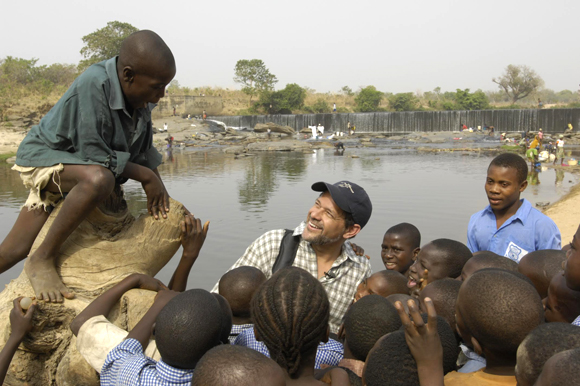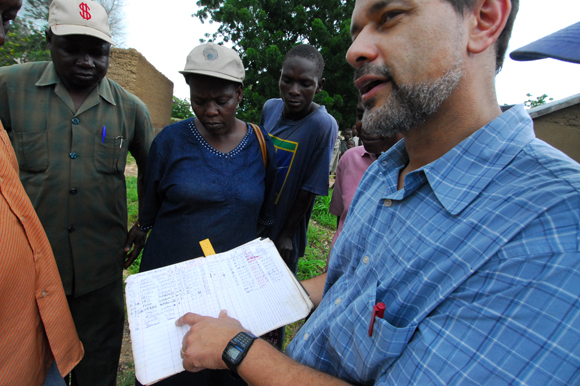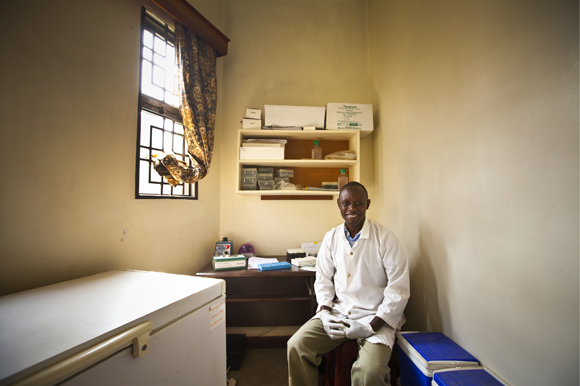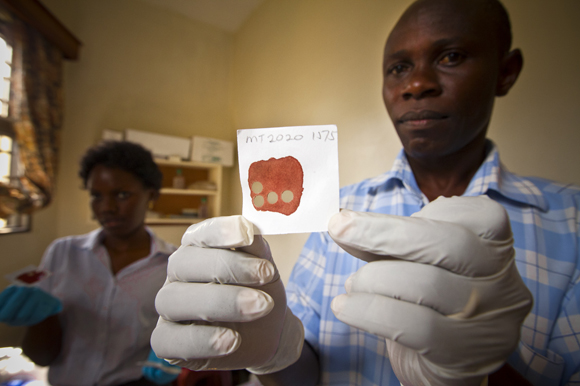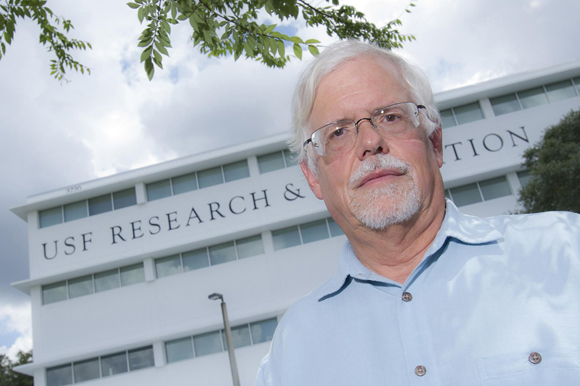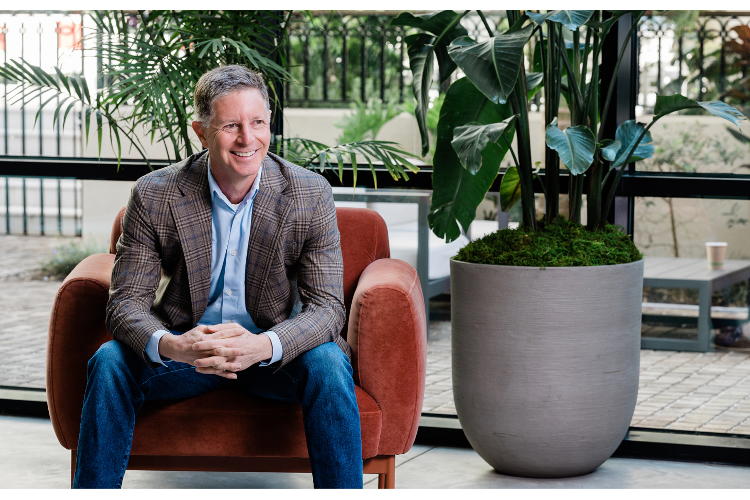USF plays pivotal role in eradication of river blindness
What motivates USF Researcher Thomas Unnasch, one of the world's leading experts on river blindness, to keep battling the global disease for almost 30 years? Read his story.
In life, some people are faced with heartbreaking problems they’re powerless to solve. Other times, that tragedy turns into triumph when there is an opportunity for positive change.
Thomas Unnasch embraced that opportunity for positive change 26 years ago.
While on a trip to Africa, he witnessed blind adults with walking sticks being led around by little children. The adults were victims of river blindness, a tropical disease which — if left untreated — can progress from skin problems to blindness.
“That trip I made to the Ivory Coast in ’92 literally changed my life,” he recalls. “I stepped into a niche a lot of other people didn’t want.”
Today Unnasch, who chairs the University of South Florida’s Department of Global Health at the College of Public Health, plays a vital role in the battle against river blindness.
His efforts have been financed by the National Institutes of Health, the National Science Foundation, the Bill and Melinda Gates Foundation, the Task Force for Global Health and the World Health Organization.
Now USF’s Department of Global Health has been designated a collaborating center for river blindness diagnoses by the Geneva-based WHO, says Dr. Paul Cantey, a Medical Officer at WHO.
Although there are more than 800 institutions supporting WHO programs, this center is the only one of its kind worldwide. It will be assisting with the development of labs that verify the elimination of river blindness as well as quality control.
“Institutions that are selected as Collaborating Centres have to have a history of working collaboratively with WHO in the past, [Dr. Unnasch has collaborated with the African Programme for Onchocerciasis Control],” Dr. Cantey says, “and agree to develop a work plan of activities that will support ongoing or new activities.”
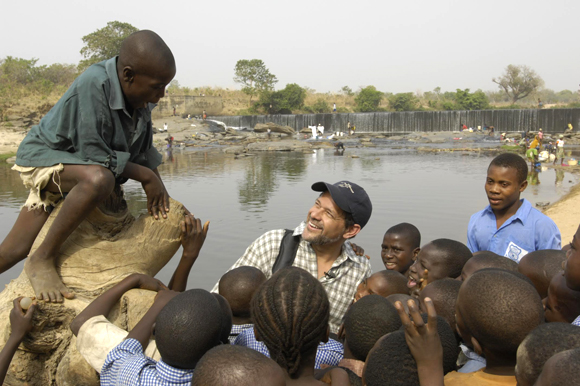
Dr. Frank Richards, an Atlanta physician and director of the river blindness project for The Carter Center, says: “This WHO designation for Tom’s labor is a way to help other countries walk that walk to the final victory … such that future generations will not suffer from this terrible condition.”
Unnasch, who holds a Ph.D. from the Massachusetts Institute of Technology, says he was invited to apply for the designation as WHO made plans to expand its lab network.
River blindness: a neglected tropical disease
River blindness is caused by a parasitic worm and spread, usually in rainy season, by black flies, which live and breed in fast-flowing waters. The flies don’t exist in the United States.
“If you don’t have the right kind of flies, you don’t have transmission,” Unnasch says.
Also known as Onchocerciasis, the illness is categorized as a neglected tropical disease. It is transmitted when people are bitten repeatedly by the blackfly, potentially causing skin nodules where the worms locate, according to the Centers for Disease Control. The skin may develop the look of ‘leopard skin’,” it says.
The worms can live up to 15 years inside the body; the larvae can survive up to two.
Though not everyone experiences symptoms, many develop nodules, itching and blindness as the body reacts to dead or dying larvae, the CDC indicates. Blindness occurs because of lesions on the cornea that, if not treated, can result in permanent clouding of vision. Inflammation to the optic nerve also can reduce vision, particularly peripheral vision, eventually causing blindness.
Early treatment is critical
Stopping the disease before it gains a foothold is critical: once someone has gone blind, there is no known cure.
The vectors have been controlled since around the early 1980s. But since then significant gains have been made to eliminate the disease through the use of an oral drug donated by the Kenilworth, N.J.-based pharmaceutical company, Merck and Co. Inc.
A dose of Mectizan™ costs approximately 25 cents, but administration and transportation costs inflate treatment expenses to 75 cents per dose. The countries, and partners like The Carter Center, disseminate the treatments.
“If they haven’t gone blind and they’re just in the early stages of the disease, it [the medicine] reverses that,” says Unnasch, who was a post-doctoral fellow in Tropical Public Health for the Harvard School of Public Health.
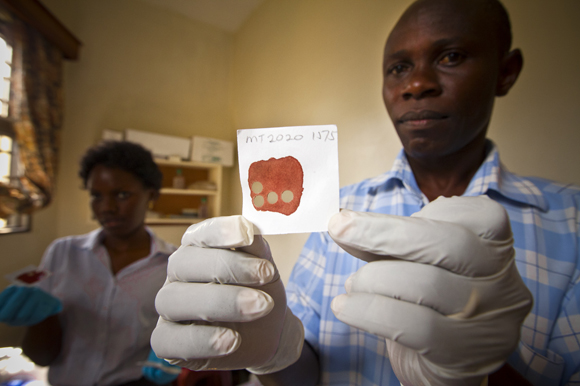
“Our treatment programs have grown from 6 million treatments a year to
55 million last year,” Dr. Richards says. “We’re somewhere around 20 percent of the whole effort.”
The drug is given to 90 percent of the population in affected areas. It isn’t approved for children under 5 or pregnant women.
“In the end, if you’re giving this drug, you’re driving this toward extinction,” Unnasch says.
Unnasch, who serves on Merck’s advisory board to help ensure the drugs are used effectively, also has been sitting on a number of other boards and helping scientists with quality control.
William C. Campbell and Satoshi Omura won the 2015 Nobel Peace Prize in Physiology or Medicine for their discovery of the Avermectin class of drugs, which includes Mectizan™. The joint award also went to Youyou Tu for her discovery of Artemisinin to reduce mortality in malaria patients.
The importance of lab work
Sensitive, molecular diagnostic techniques are required to determine if the disease is eliminated.
“Proving a zero is not an easy thing to do,” Dr. Richards explains. “It was Tom’s help that allowed us to have the test with the degree of sensitivity to really tell when we reached a point where it was safe to stop treatment.”
What the testers do is gather lots of vector flies and check them for human parasites.
“If there’s no parasites, there’s no transmission,” Unnasch says. “If there are none for five or six years, probably we’re good.”
They retest again in three years just to be sure.

Dr. Richards, who started collaborating with Unnasch more than two decades ago, says Unnasch’s efforts have led to the establishment of eight labs needed to prove when parasites are no longer transferring the disease.
“You can control the disease by giving this medicine Mectizan™ so that people are not blind,” he explains. “If you don’t break the transmission of the parasite, you have to treat the population indefinitely.”
Unnasch has built a reputation as an expert in setting up the labs.
“He has gained well-deserved recognition as the man to go to,” Dr. Richards continues. “He’s done it in the Americas and he’s done it in Africa.”
Dr. Richards describes Unnasch as an energetic researcher who knows what needs to be done.
“My passion is delivery, service delivery, deployment of the best available tools,” he says. “Having Tom available to help with that is good as gold.”
Unnasch’s research spans 33 years
Unnasch’s research on river blindness dates back to 1985, when he accepted a job at the Cleveland-based Case Western Reserve University. There, his work involved identifying the river blindness parasite.
His research continued when he moved on in 1989 to the University of Alabama in Birmingham. There he trained his first scientist, Dr. Laurent Toe, the DNA Lab Director for the Onchocerciasis Control Programme in West Africa.
When WHO wanted to replicate his lab on the Ivory Coast, Unnasch went to Africa to help set it up. On a weekend off, he traveled to the village of Asubende in Ghana, where about 50 of the 150 residents were blind because of Onchocerciasis.
“It was horrible,” he recalls.
He became involved with a river blindness program in West Africa with WHO, plus with the Carter Center through supporting labs in Latin America and Africa.
Part of that job involved training lab technicians. Among them was David Oguttu, a parasitologist/laboratory scientist who now manages the National Onchocerciasis Elimination Program in Uganda. Unnasch selected Oguttu for more intensive training in Birmingham in 2007.
“Tom trained me to cherish quality results, build a good team to run the lab and produce quality data, which the Ministry of Health has to rely on to make decisions on Onchocerciasis elimination,” he says. “The Uganda lab still gets technical support from the Unnasch Florida lab.”
That Uganda lab, located in the country’s Ministry of Health, has in turn trained technicians from Sudan, Ethiopia and the Democratic Republic of Congo.
Oguttu says the techniques he learned from Unnasch are vital to their work. “Without such a lab it is hard to determine whether disease elimination has been achieved,” he says.

Uganda has eliminated river blindness in seven of the country’s 17 endemic zones, and interrupted transmission of the disease in eight more, Oguttu says.
“The only two zones with transmission are located at the border with Congo and South Sudan. Cross-border collaborations have been established to eliminate cross-border transmission of Onchocerciasis,” he adds.
Unnasch says elimination efforts in Africa are expected to target Togo, Tanzania and Ghana in the next three years. Later on, the effort is expected to expand to Cameroon and Nigeria, where there already is a Carter Center Lab, and eventually reach the Congo.
“That’s the heart of the Central African environment. We’re going to have to get in there and deal with that,” says Unnasch, who has worked at USF for more than a decade.
In Latin America, the disease has been defeated in all but a very remote area of Brazil and Venezuela, where 20,000 remain at risk.
“They’re really hard to get to, which is why we haven’t managed to actually solve that problem,” Unnasch explains. “It’s a difficult place to work.”
Making a difference
The WHO designation itself doesn’t come with funding, so Unnasch is seeking $150,000 in funding for direct costs in the initial year.
“I try to do this cheaply,” he says.
He expects to hire at least one additional staff member for the new center.
So far the results of efforts to defeat river blindness have been dramatic. So much so, that it’s no longer common to see people with river blindness walking around with sticks as Unnasch saw three decades ago.
“They don’t really know anything about this disease anymore,” he says.
For Unnasch, that’s been very rewarding. “It’s probably the most rewarding thing that I’ve done,” he says. “I’ve been part of making a real difference.”

